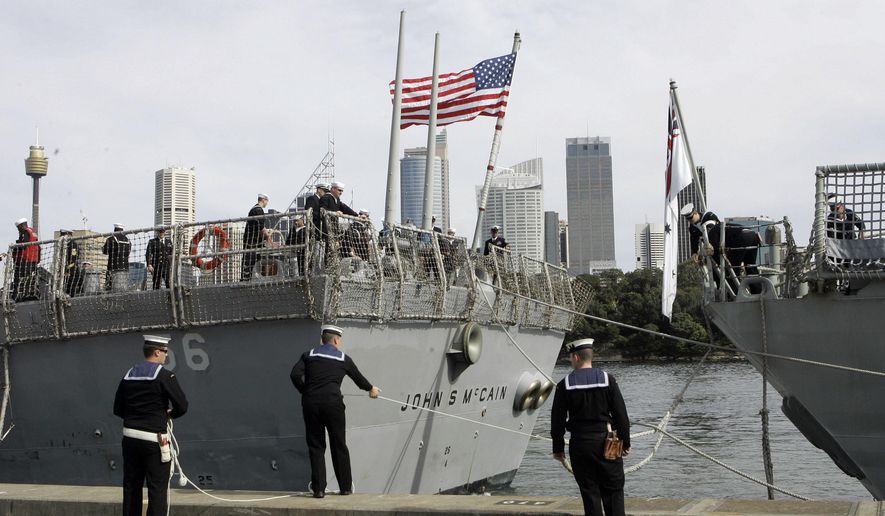BEIJING (AP) - A look at recent developments in the South China Sea, where China is pitted against smaller neighbors in multiple disputes over islands, coral reefs and lagoons in waters crucial for global commerce and rich in fish and potential oil and gas reserves:
___
EDITOR’S NOTE: This is a weekly look at the latest developments in the South China Sea, the location of several territorial conflicts that have raised tensions in the region.
___
U.S., AUSTRALIA HOLD ANTI-SUBMARINE EXERCISE
The U.S. and Australian militaries are joining for an annual anti-submarine exercise focused on ensuring freedom of navigation and the “free flow of commerce in the region.”
The 2019 Exercise Sea Dragon starts Monday at Andersen Air Force Base in the western-most U.S. territory of Guam, which is considered a tempting target for China or North Korea in the event of a conflict. Slated to run 11 days, the exercise is “an exciting opportunity to … focus on building anti-submarine warfare proficiency and increase warfighting lethality,” Capt. Brian Erickson, Commander of Task Force 72, was quoted as saying in a 7th Fleet news release.
“Exercise Sea Dragon illustrates that the U.S. and our partners stand ready to ensure the freedom of navigation and the free flow of commerce wherever international law allows,” the 7th Fleet said.
Freedom of navigation operations are a key point of contention in the South China Sea, where the U.S. says it will sail and fly wherever international law allows. China interprets international law differently, and calls such missions dangerous and destabilizing, regularly dispatching aircraft and ships in response to them.
Units from the Royal Australian Air Force will join U.S. units throughout the exercise.
Four U.S. and one RAAF P-8A Poseidon anti-submarine aircraft will be conducting flight operations with support from a mobile tactical operations center during the exercise. They will work against both simulated and live targets, including a Los Angeles-class attack submarine.
___
TOP U.S. NAVY OFFICER VISITS CHINA
The U.S. Navy’s top officer is visiting China this week amid increasing frictions. Chief of Naval Operations Adm. John Richardson will meet with his Chinese counterpart, Vice Adm. Shen Jinlong, and leaders of China’s Central Military Commission during a visit to Beijing and the eastern city of Nanjing that runs through Wednesday.
The goal of the visit, Richardson’s second as head of operations, is to “continue a results-oriented, risk reduction focused dialogue” between the two militaries, the Navy said.
“A routine exchange of views is essential, especially in times of friction, in order to reduce risk and avoid miscalculation,” the release quoted Richardson as saying.
China’s objections to U.S. freedom of navigation patrols will likely feature high in the talks. Richardson has said such missions highlight the U.S. position against “illegitimate maritime claims.”
Deep mistrust lingers between the sides. Last summer, Washington disinvited China from a major U.S.-sponsored naval exercise in what it called “an initial response” to China’s militarization of the South China Sea.
___
CHINESE WARSHIPS STOP IN CAMBODIA
Three Chinese warships arrived in Cambodia last Wednesday on a visit aimed at strengthening already close ties between the two nations.
Cambodian Defense Ministry spokesman Gen. Chhum Socheat said the ships, carrying nearly 700 crew members, docked at the port of Sihanoukville on the country’s southern coast. He said a total of 17 warships from China have visited Cambodia in recent years.
In 2016, Cambodia hosted its first major naval and ground joint exercises with Chinese forces.
Cambodia has grown increasingly close to China in recent years as the government of long-serving Prime Minister Hun Sen has become estranged from the United States, which is critical of his authoritarian rule.
China is Cambodia’s most important political and economic ally. It has provided millions of dollars in aid and investment over the past decade, agreed to write off debts and granted Cambodia tariff-free status for hundreds of items.
Cambodia, in turn, has demonstrated its willingness to do Beijing’s bidding in diplomatic initiatives in the region, especially regarding Chinese territorial claims in the South China Sea.
___
CHINESE NAVAL OFFICER: MORE ISLAND DEVELOPMENT POSSIBLE
A Chinese naval officer says China may further fortify man-made islands in the South China Sea depending on threats faced by the outposts.,
Navy academy researcher Senior Capt. Zhang Junshe last week repeated China’s stance that it has the legal right to take whatever measures it deems appropriate on the islands in the South China Sea, which China claims virtually in its entirety.
“If our on-island personnel and installations come under threat in the future, then we necessarily will take measures to boost our defensive capabilities,” Zhang, a senior researcher at the institute, said at a briefing for Chinese and foreign journalists.
Pentagon officials have long said that China has failed to fulfill a 2015 pledge by President Xi Jinping not to expand development in the area, where it has built seven islands by piling sand and cement on coral reefs, equipping some with airfields.
China says the development primarily serves civilian purposes.
Five other governments have territorial claims that overlap with China’s in the strategically vital waterway.
Zhang also accused the U.S. of endangering safety and security in the region, citing the U.S. Navy’s freedom of navigation operations, in which it sails close to Chinese-held islands, arousing Chinese ire.




Please read our comment policy before commenting.